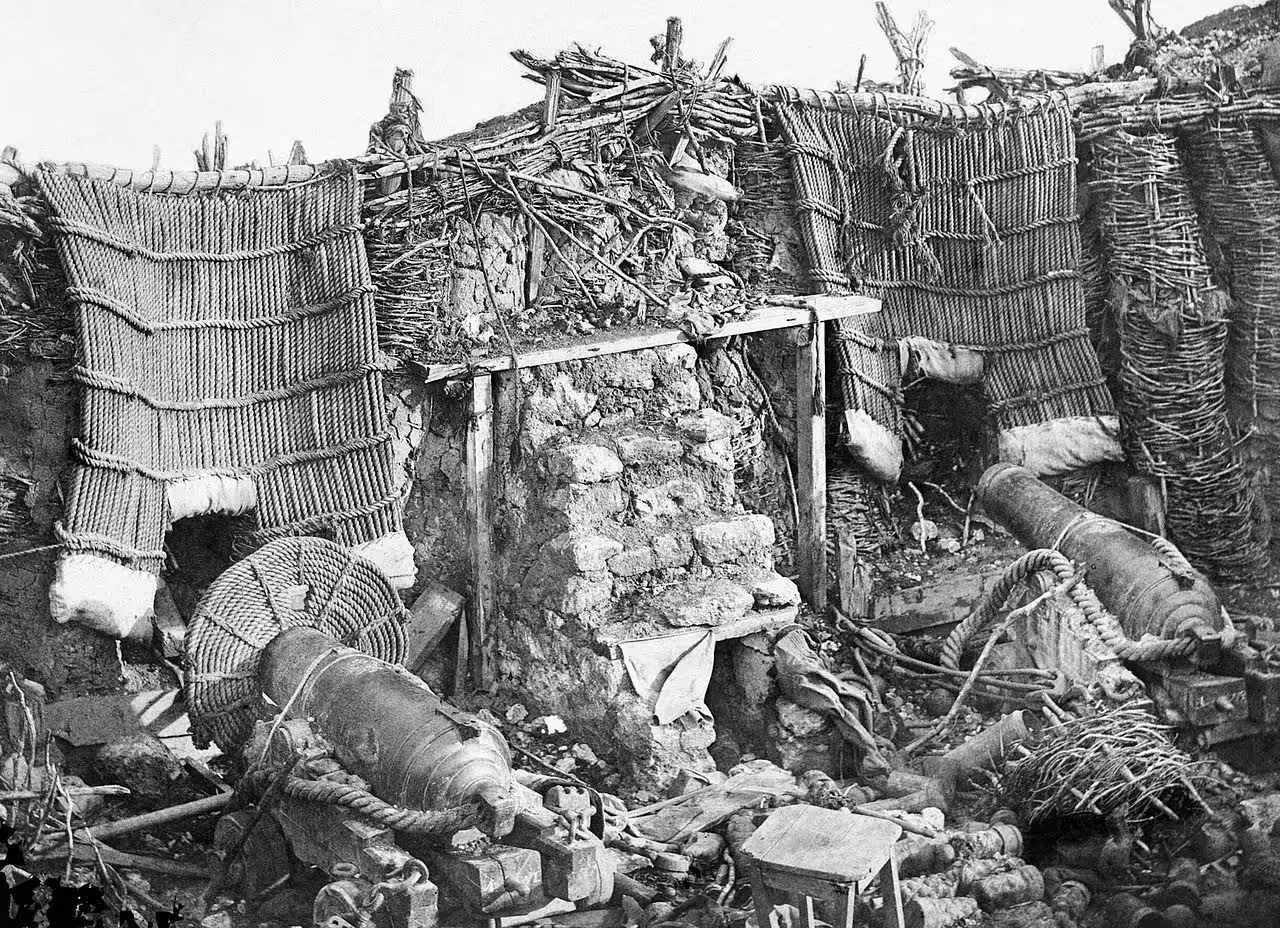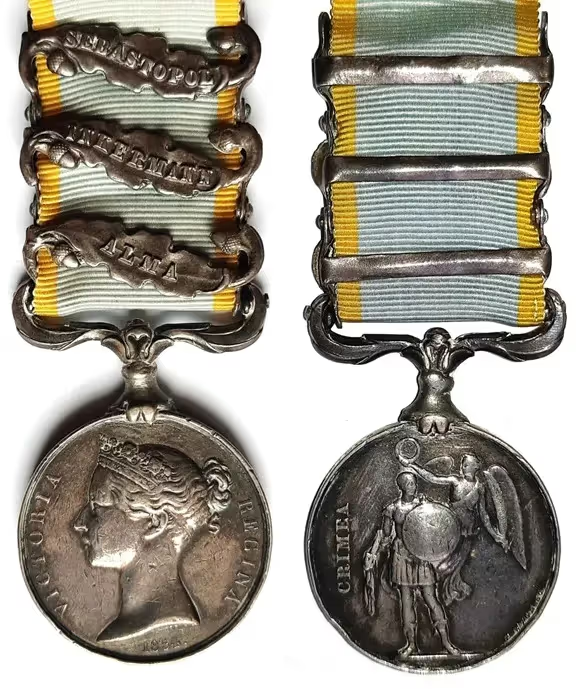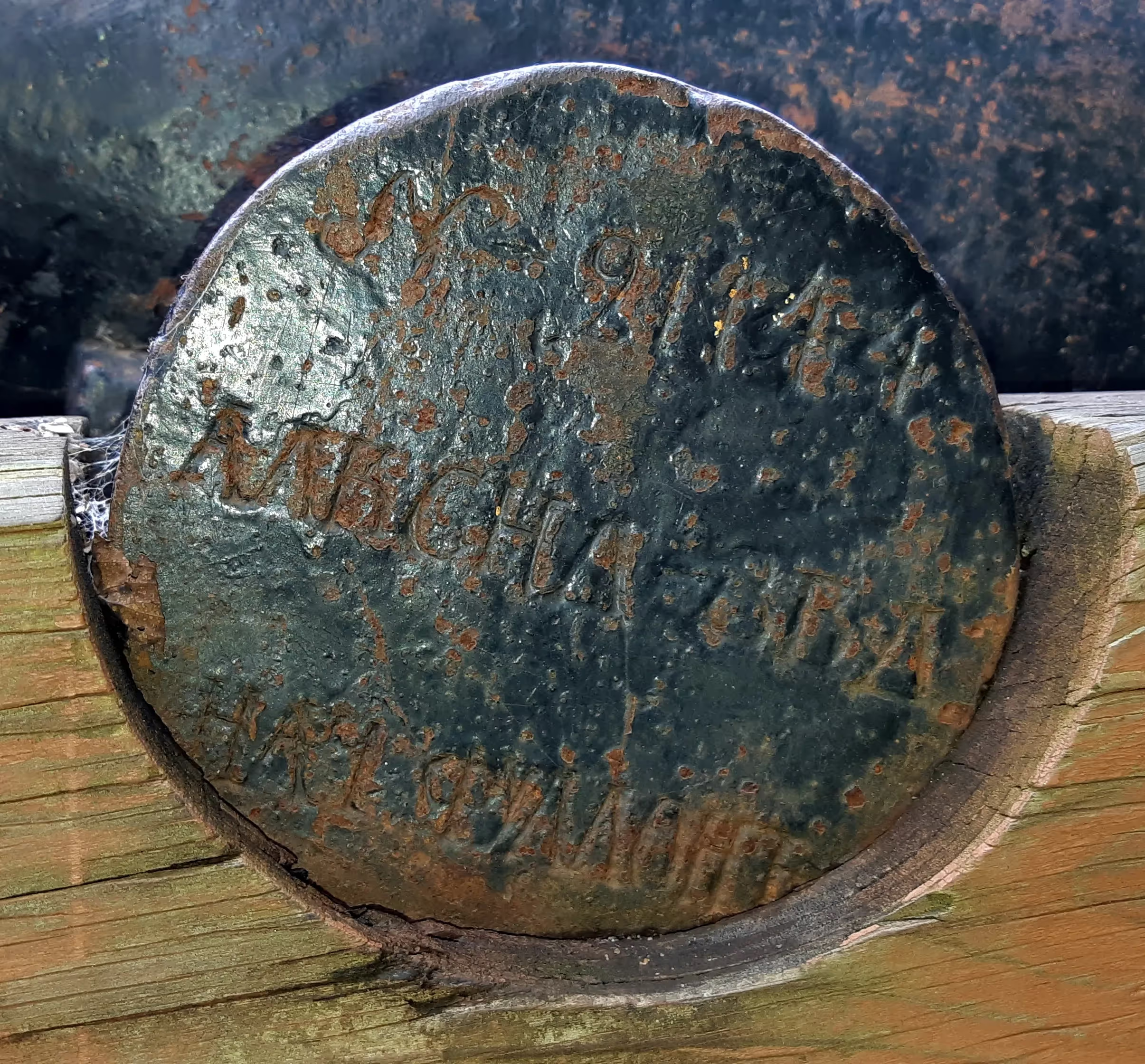Artillery in Canada: Russian Crimean War Trophy Guns
Russian Crimean War Trophy Guns preserved in Canada

(IWM Photo, 71229)
The Crimean War, 1854 - 1856 The ruins of the Barrack Battery, one of the six main redoubts which defended Sevastopol, showing the rope mantlets adopted by the Russians for the protection of the gunners.
The Crimean War was fought between Oct 1853 and Oct 1856, between Russia and Turkey. Turkey called on its allies, Britain, France and Sardinia, for support. The primary battle took place for possession of the Russian seaport at Sevastopol on the Black Sea in Crimea. Sevastopol was under siege for most of the war from Oct 1854 to Sep 1855, with great loss of life on all sides. The Treaty of Paris ended the war in March 1856, and the allies collected some 4,000 Russian guns. Half of these went to France, and about 1,500 went to England, along with hundreds of brass guns at the end of the Crimean War. Many of the guns captured at the great Russian Naval base of Sevastopol in the Crimea were offered for display in towns and cities throughout the UK and the British Empire.
20 of these captured guns were presented to Canada, and in the fall of 1857 they were put on display in Montreal before being distributed to other cities. Pairs of guns were sent to Brantford, Cambridge, Galt, Hamilton, Kingston, London, Montreal, Ottawa, Quebec City, Stratford, Trois Rivieres, Toronto and Windsor. 18 of these guns survive, one of the Hamilton guns was destroyed by vandals.
The siege of Sevastopol (at the time called in English the siege of Sebastopol) lasted from October 1854 until September 1855, during the Crimean War. The allie forcs (British, French and Ottoman) landed at Eupatoria on 14 September 1854, intending to make a triumphal march to Sevastopol, the capital of the Crimea, with 50,000 men. The 56-kilometre (35 mi) traverse took a year of fighting against the Russians. Major battles along the way were Alma (September 1854), Balaklava (October 1854), Inkerman (November 1854), Tchernaya (August 1855), Redan (September 1855), and, finally, Sevastopol (September 1855). During the siege, the allied navy undertook six bombardments of the capital, on 17 October 1854; and on 9 April, 6 June, 17 June, 17 August, and 5 September 1855.
Sevastopol is one of the classic sieges of all time. The city of Sevastopol was the home of the Tsar's Black Sea Fleet, which threatened the Mediterranean Sea. The Russian field army withdrew before the allies could encircle it. The siege was the culminating struggle for the strategic Russian port in 1854–55 and was the final episode in the Crimean War. (Bellamy, Christopher (2001). Richard Holmes (ed.). The Oxford Companion to Military History: Crimean War. Oxford University Press.

(Valentin Ramirez Photo)
Siege of Sevastopol 17 Oct 1854 – 9 Sep 1855, by Franz Roubaud.
French Translation of the technical data presented here would be appreciated. Corrections, amendments and suggested changes may be emailed to the author at [email protected].
Une traduction au français pour l'information technique présente serait grandement apprécié. Vos corrections, changements et suggestions sont les bienvenus, et peuvent être envoyés au [email protected].

(Author Photos, YSHS, FRM Collection)
Crimean War Medal, with bars for Sevastopol, Inkermann, and Alma.
Introduction:
This web page is primarily about where to find the historic Russian guns taken by British forces during the Crimean War that are currently on display in Canada. A few of these Russian artillery pieces found in Canada today may have been missed, and updates on where and what they are would be most welcome. These guns have been part of Canada’s history, and as such every effort to preserve and document the survivors should be made in order to keep their story from fading.
Russian Guns from the Crimean War in Canada
Brantford, Ontario





Right trunnion. (The Blue Quasar Photos)
Russian 24-pounder (TBC) SBML Gun by Foullon with double-headed Eagle, Crimean War trophy, mounted on a Naval wooden wheeled carriage. (Serial No. 22606) on left trunnion, Cyrillic AKCHD ZBD (AKSND ZVD) on the right trunnion. The left trunnion carries the serial number, the name of the maker and its director, the right trunnion is engraved with the calibre, type of gun, weight, and date of casting. There appears to be shot damage on the side of the gun and a chip is missing from the lip of the muzzle with additional damage on the barrel. This gun is reported to have been brought to Canada by the British 7th Fusiliers as war booty. This unit was stationed in Brantford Ontario in 1863 and when the regiment returned to Britain after the end of the American Civil War they gifted the gun to the City. This gun stands in Alexandra Park.
Cambridge Galt, Ontario




(JustSomePics Photos)
Russian Cast Iron 24-pounder 50-cwt Smoothbore Muzzleloading Gun, by Butyenev, with double-headed Eagle, Crimean War trophy, (Serial No. 29619), 24. Captured by the British in the Crimean War, on display in Cambridge on 10 September 1855, given to Galt in 1863. Mounted in Queen’s Square. The left trunnion carries the serial number, the name of the maker and its director, the right trunnion is engraved with the calibre, type of gun, weight, and date of casting.
Fort Erie, Ontario











(Author Photos, 23 Apr 2015)
Russian Blomefield 36-pounder SBML, made by Armstrong, at Alexandrovski, with double-headed Eagle, Crimean War trophy. ML, (Serial No. 433G), 1632P, 1835. Mounted on a wood naval gun carriage located on a redoubt facing south inside Fort Erie.
Hamilton, Ontario, HMCS Star, Naval Reserve

(Author Photo, 24 Apr 2015)
Russian Blomefield 36-pounder SBML, made by Armstrong at Alexandrovski, with double-headed Eagle, Crimean War trophy. 6.75-inch gun, stamped Armstrong 1837 J68 ½, (Serial No. 25457). Captured at Sevastopol in 1855, given to Hamilton by Queen Victoria in 1860. The Hamilton and District Officers’ Institute mounted the gun as a centennial project in 1967. This gun is now mounted on a concrete stand at HMCS Star.
Kingston, Ontario, Sir John A. MacDonald Memorial
Sir John A. MacDonald Memorial, flanked by a pair of Russian Smoothbore Muzzleloading Guns captured during the Crimean War and presented to Canada by Queen Victoria. The British seized some 1,500 iron SBML guns and hundreds of bronze cannon at the end of the Crimean War (1853-1856). Shortly afterwards, guns captured at the great Russian Naval base of Sevastopol in the Crimea were offered for display in towns and cities throughout the UK and the British Empire. The City of Kingston received two of these guns.








(Author Photos, 28 Oct 2017)
Russian 36-pounder SBML Gun, (Serial No. 20565) on left trunnion, (36 P, 168 1/2 P, 1826, G) on right trunnion, probably cast by Foullon at Alexandrovski, with double-headed Eagle, 6.75 calibre, 8 feet 4-inches long, mounted on a wood naval gun carriage, Crimean War Trophy, 1854-1855, No. 1 in front of the Sir John A MacDonald statue, King and West Street park.



(Author Photos)
Russian 36-pounder SBML Gun, (Serial No. 19808) on right trunnion, (36P, 168 1/9, 1823) on left trunnion, probably cast by Foullon at Alexandrovski, with double-headed Eagle, 6.75 calibre, 8 feet 4-inches long, mounted on a naval gun carriage, Crimean War Trophy, 1854-1855, No. 2 in front of the Sir John A MacDonald statue, King and West Street park.
London, Ontario

(Terry Honour Photo)
There are three Smoothbore Muzzleloading Guns in Victoria Park (one British and two Russian) presented to Canada by Queen Victoria, standing in front of the Boer War Memorial.






(Terry Honour Photos)
Millar pattern Russian Cast Iron 24-pounder 50-cwt SBML Gun, Serial No. 28145) forged by Armstrong at Alexandrovski on the left trunnion, (24P BbCY 140 1/2 P) on right trunnion, double-headed Eagle, Crimean War trophy, MA stamped above the cascabel. This gun has damage on its muzzle. No. 3 gun mounted on a brick and concrete stand, East of the Boer War Memorial, Victoria Park.




(Terry Honour Photos)
Millar pattern Russian Cast Iron 24-pounder 50-cwt SBML Gun, (Serial No. 29716) forged by Armstrong at Alexandrovski on the left trunnion, (24P BbCY 140 1/2 P) on right trunnion, double-headed Eagle, Crimean War trophy, MA stamped above the cascabel. This gun has what appears to be damage from a shell strike on the right side near the breech. No. 1 gun mounted on a brick and concrete stand in front of the Boer War Memorial, Victoria Park.
Stratford, Ontario






(Terry Honour Photos)
Russian Millar pattern Cast Iron 24-pounder 50-cwt SBML Gun, (Serial No. 29565), forged by Armstrong at Alexandrovski, with double-headed Eagle, Crimean War trophy, stamped 1845, MA on breech, tv, ck. Located near the city cenotaph. The swell on the muzzle is broken.
Toronto, Ontario, Queen’s Park Legislature

(Terry Honour Photo)



(Author Photos, 26 Apr 2015)
Russian Cast Iron 68-pounder, 8-inch Smoothbore Shell Gun with Millar pattern breeching ring, stamped 1840, (Serial No. 27054), Crimean War trophy gun captured at Sebastopol, given to Toronto in 1859, mounted on a concrete stand. A plaque states, “Presented by Queen Victoria to the Citizens of Toronto A.D. MDCCCLIX” (1859), southwest of building entrance. outhwest of building entrance. Queen’s Park Legislature.






(Author Photos, 26 Apr 2015)
Russian Cast Iron 68-pounder, 8-inch Smoothbore Shell Gun with Millar pattern breeching ring, stamped 1840, (Serial No. 29769), Crimean War trophy gun captured at Sebastopol, mounted on a concrete stand. It is marked with a plaque, “Presented by Queen Victoria to the Citizens of Toronto A.D. MDCCCLIX” (1859), southeast of building entrance. Queen’s Park Legislature.
Windsor, Ontario

(City of Windsor Photo)
Russian Cast Iron 24-pounder 50-cwt SBML Carronade, forged by Armstrong at Alexandrovski, with double-headed Eagle, Crimean War trophy with trunnions intact, mounted on a concrete stand in Assumption Park, on the riverfront. The guns is mounted on a concrete stand marked “SEBASTOPOL” 1855.
Isle St Helene, Montreal
Russian 24-pounder (TBC) SBML Gun by Foullon at Alexandrovski, with double-headed Eagle, Crimean War trophy.
Place du Canada, Montréal
.avif)
.avif)
.avif)
.avif)
.avif)
.avif)
.avif)
.avif)
(Rejean Montmarquet Photos)
Russian Cast Iron 30-pounder SBML Gun, weight 252 pood (252 X 36.11 = 9,099. 72 lbs), (30 lb, 252 pood, 1802) on the left trunnion, (Serial No. 8741, Alexandrovski, Gascoigne) on the right trunnion, forged by Gascoigne at Alexandrovski with double-headed Eagle, 31 on the button. This Crimean War trophy is mounted on a concrete stand, No. 1 of 2 at Place du Canada.
.avif)
.avif)
.avif)
.avif)
.avif)
.avif)
.avif)
.avif)
.avif)
(Rejean Montmarquet Photos)
Russian Cast Iron 30-pounder SBML Gun, weight 252 pood (252 X 36.11 = 9,099. 72 lbs), (30 lb, 252 pood, 1802) on the left trunnion, (Serial No. 8486, Alexandrovski, Gascoigne) on the right trunnion, forged by Gascoigne at Alexandrovski with double-headed Eagle, 3 on the button. This Crimean War trophy is mounted on a concrete stand, No. 2 of 2 at Place du Canada.
Canon SBML en fonte russe de 30 livres, poids 252 poud (252 X 36,11 = 9 099, 72 lb), (30 lb, 252 poud, 1802) sur le tourillon gauche, (N° de série 8486, Alexandrovski, Gascoigne) sur la droite tourillon, forgé par Gascoigne à Alexandrovski avec Aigle à deux têtes, 3 au bouton. Ce trophée de la guerre de Crimée est démonté, n° 2 sur 2 à la Place du Canada.
Les deux canons de Sébastopol, près du monument à Sir John A. Macdonal situés au centre de la place du Canada, sont un don de la reine Victoria. Les canons de Sébastopol. Entre 1854 et 1856, la guerre de Crimée est surtout un conflit d’influence entre les grandes puissances européennes de l’époque. Provenant de l’Angleterre, le 39e Régiment, qui est en poste à Montréal, participe à cette guerre et revient triomphalement au pays en juillet 1856. Pour souligner la bravoure de ses soldats, la reine Victoria offre aux régiments combattants des canons saisis pendant les affrontements. À Montréal, deux sont d’abord exposés dans le Vieux-Montréal à proximité du cantonnement britannique. Selon les sources, ils sont ensuite déplacés au square Dominion à la fin des années 1870, 1889 ou 18922.
Capturés lors de la bataille de Sébastopol en Ukraine, ces artéfacts sont des pièces d’artillerie authentiques se composant d’un fût et d’une base. À l’origine sculptée dans le bois, la base est aujourd’hui remplacée par une réplique en ciment. Les artéfacts sont fabriqués d’un alliage de bronze et de métal. Il s’agit des premiers objets à embellir le square. Leur matériau, leurs formes anciennes et les aigles gravés du tsar de la Russie impériale sur leur fût inscrivent ces canons dans le passé. Leur présence témoigne des armes de guerre au XIXe siècle et évoque la dure réalité du soldat lors des conflits. Les canons rappellent aussi l’état colonial d’antan du pays.
Au tournant du XXe siècle, les canons attirent les touristes américains qui les aperçoivent en sortant de la nouvelle gare Windsor. Ils s’empressent de les photographier, car le bruit court aux États-Unis qu’ils ont servi à repousser l’invasion américaine.
Quebec City, Quebec








(Author Photos, 16 June 2016)
Russian Cast Iron 24-pounder Smoothbore Muzzleloading Gun, weight corroded, Serial No. 64312 on left trunnion, forged by Gascoigne at Alexandrovski with double-headed Eagle, Crimean War trophy with trunnions, mounted on an iron garrison carriage. West side of the Promenade in front of Chateau Frontenac. No. 5.








(Author Photos, 16 June 2016)
Russian Cast Iron 24-pounder SBML Gun, weight corroded, Serial No. 7379 on left trunnion, forged by Gascoigne at Alexandrovski with double-headed Eagle, Crimean War trophy with trunnions, mounted on an iron garrison gun carriage. East side of the Promenade in front of Chateau Frontenac. No. 6.
Trois-Rivières, Quebec








(Author Photos, 4 Oct 2019)
Russian 24-pounder SBML Gun, weight unknown, dated 1828, (Serial No. 21144), forged by Foullon at Alexandrovski, with double-headed Eagle, Crimean War trophy, mounted on a wooden box, Place d’Armes.
High Prairie, Alberta
Russian 36-pounder (TBC) SBML Gun from the Crimean War era, minus its carriage, mounted on concrete blocks. This gun was reported to have been located in a park beside the Royal Canadian Legion Branch No. 37, 4721, 51st Ave. The gun has been moved and its present location is unknown.





